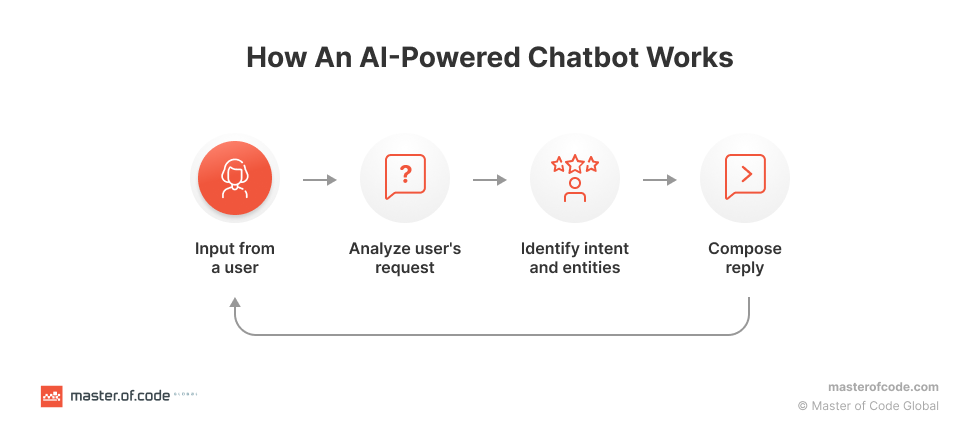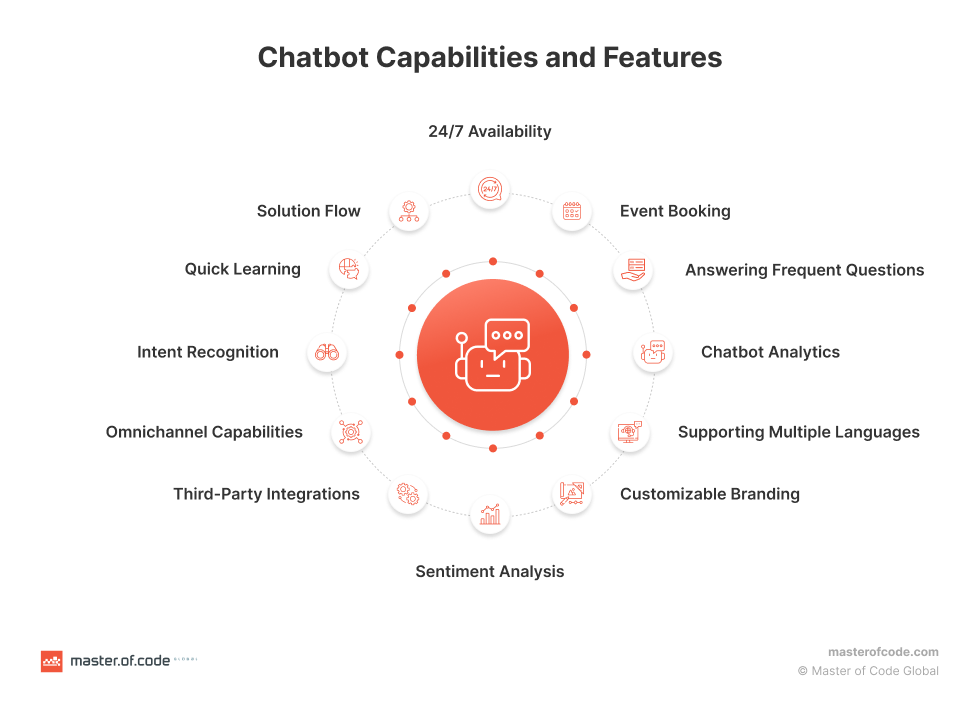In modern business, the integration of technology has become crucial for achieving success. Among the innovative tools driving this transformation, chatbots have emerged as powerful assets, reshaping customer interactions and raising operational efficiency. As businesses try to enhance their customer support, streamline processes, and elevate user experiences, harnessing the capabilities of chatbots has evolved into an indispensable strategy.
In this article, we delve into the advanced chatbot features that drive businesses towards success. Drawing from the expertise of Master of Code, a leader in chatbot development and conversational experiences, we uncover the 12 essential chatbot features that possess the potential to redefine how businesses engage with customers and achieve their objectives.
Table of Contents
What is a chatbot?
A chatbot is a clever computer program that can talk to people, much like you and me. It’s like having a virtual friend who can grasp your words and reply in turn. These features are frequently employed on websites or messaging apps to assist in answering questions or engaging in conversations with customers. They’re really handy because they can save time and provide assistance even when humans are unavailable.
Modern chatbots are AI systems designed to interact with participants in a manner just like humans do, leveraging their chatbot capabilities. They employ advanced techniques like deep learning and natural language processing (NLP) to hold conversations in a natural way.
Difference between rule-based and AI chatbot
Numerous business owners intend to implement a chatbot to enhance customer service and boost sales. However, a crucial decision they need to make is whether to opt for a rule-based chatbot or choose an AI-driven one. Let’s explore the world of rule-based and AI chatbots, understanding their characteristics and the best chatbot features that make them great.
A rule-based chatbot is a type of chatbot that operates on predefined sets of rules and responses. These rules are established by human programmers and are used to guide the chatbot’s interactions with users. When someone inputs a query or message, the chatbot searches its rule database for a matching rule and responds accordingly.
One of the key features of rule-based chatbots is their ability to excel at handling specific and structured tasks, as they rely on predetermined patterns. However, they may struggle with managing complex or unpredictable conversations, as their responses are confined to the rules they’ve been programmed with.
An AI chatbot is a sophisticated virtual assistant that leverages advanced algorithms and machine learning (ML) techniques to act in a human-like manner.
Unlike rule-based chatbots, AI chatbots can dynamically adapt and learn from communications, improving their responses over time. AI chatbot features cover natural language processing (NLP) capabilities, enabling them to understand and interpret input, regardless of its structure or wording. They can analyze context, extract intent, and provide contextually relevant responses. Additionally, AI chatbots often integrate sentiment analysis, enabling them to gauge customers emotions and tailor their actions accordingly. These features of chatbots collectively create more engaging, personalized, and efficient conversations.
The primary difference between AI chatbots and rule-based chatbots lies in the usage of machine learning models, which substantially enhance chatbot capabilities. This allows the bot to recognize a wide array of questions composed by humans, resulting in more perceptive and adaptable reasoning.
How Do AI-Powered Chatbots Actually Work?
Let’s take a look at the basic understanding of how an AI chatbot operates and the process of AI chatbot interactions.

Customers can submit queries to AI chatbots in a way that mirrors interacting with human agents. The bot utilizes a text classifier to identify intent and grasp the contextual context of the question.
Subsequently, a series of supplementary questions and responses is formulated using a solution flow, aiding in precisely pinpointing the specific issue the customer wishes to address, along with the proposed solutions.
Furthermore, integration with back-end systems through APIs empowers the bot to execute tasks on behalf of the customer, extending its role beyond merely offering self-service instructions.
Natural language processing models empower an AI chatbot to identify a wide range of diverse questions, making it exceptionally valuable for prominent enterprises in both the public and private sectors, including domains such as telecommunications, banking, and insurance. This bot feature enables autonomous assistance to thousands of customers, independent execution of intricate tasks, and effective recognition of more complex scenarios. The finest examples of chatbots demonstrate the remarkable capabilities and features of these virtual assistants.
Chatbot Capabilities and Features

24/7 Availability
One of the key features is their 24/7 availability, enabling support around the clock. This chatbot benefit ensures that clients can engage with the bot whenever they need assistance or information, regardless of the time of day.
According to Salesloft, 64% of internet users consider 24-hour service to be the most beneficial feature of chatbots. Whether it’s addressing queries, offering guidance, or facilitating transactions, the constant accessibility of chatbots enhances customer convenience and satisfaction by removing time constraints and accommodating diverse schedules.
Solution Flow
When clients encounter an issue or seek assistance, the chatbot employs this feature to systematically lead them through a predefined series of inquiries. These questions are designed to extract relevant information and context, enabling the chatbot to understand the situation accurately. Based on the information gathered, the chatbot then provides tailored responses or recommendations, progressively assisting towards a solution.
This guided approach ensures that the person receives relevant and targeted support, enhancing their experience and increasing the likelihood of resolving their concerns efficiently. As per the report, more than 87% of customers state that chatbots proficiently address their issues.
Answering Frequent Questions
According to Invesp, chatbots not only respond to 80% of routine questions but also do so 80% more quickly compared to live agents. The feature involves programming the chatbot to provide accurate and consistent responses to commonly asked questions from customers. It involves creating a database of predefined answers and training the bot to recognize specific keywords or phrases in inquiries. AI FAQ chatbot efficiently manages routine questions, effectively saving time and improving customer satisfaction.
Quick Learning
Through the process of machine learning, chatbots analyze input and feedback from customers, enabling them to identify patterns and understand preferences. The capabilities of AI chatbots to acquire knowledge and refine their performance based on interactions with users
Consequently, chatbots consistently improve their ability to provide accurate and relevant responses. This feature ensures that bots evolve over time, staying current with changing clients needs and trends.
Intent Recognition
Intent recognition serves as a foundational aspect of chatbot functionality, encompassing the chatbot’s proficiency in perceiving and comprehending the underlying purpose or intention conveyed through the messages. Through an analysis of words, phrases, and contextual cues in a user’s input, the chatbot diligently seeks to accurately determine the user’s objective or query.
These dynamic capabilities empower it to systematically categorize the user’s question or message into preordained classifications or themes, known as intents. Upon identifying the intent, the chatbot expertly constructs and delivers responses that harmonize with the user’s specific intention, thus elevating the quality and efficacy of the involvement. This advanced chatbot feature significantly enhances its capacity to grasp user requirements, dispense accurate information, and facilitate substantive conversations.
Omnichannel Capabilities
Multi-platform deployment, a key feature of omnichannel capabilities, refers to proficiency in operating smoothly and consistently across diverse platforms: websites, messaging applications, and social media platforms.
This implies that regardless of the user’s choice of engagement – be it through a website, messaging app, or social media channel – the chatbot maintains a uniform customer experience and provides consistent service quality. This seamless transition between platforms ensures effortless access to the chatbot’s assistance or information, regardless of the preferred communication channel.
Third-Party Integrations
When integrated with a payment gateway, a chatbot can facilitate transactions and process payments directly within a conversation. Similarly, integration with CRM systems enables the virtual assistant to access customer data and history, offering personalized interactions and assistance. These integrations expand the bot’s functionalities beyond its native chatbot capabilities, making it a tool for streamlining various tasks.
Sentiment Analysis
Sentiment Analysis involves the chatbot’s proficiency in gauging the emotions conveyed within user messages. As stated by Insider, nearly 40% of worldwide Internet users prefer chatbots to human agents for customer service communication.
By assessing the tone, language, and context used in the input, the bot can determine whether the sentiment is positive, negative, or neutral. This enables the chatbot to tailor its responses to match the person’s emotional state.
For instance, if someone expresses frustration, the chatbot can provide empathetic responses and offer solutions to alleviate their concerns. On the other hand, if a person is positive, the bot can respond with enthusiasm and positivity.
Customizable Branding
By customizing the chatbot’s look and feel to mirror the company’s branding guidelines, the chatbot becomes a seamless extension of the brand’s online presence. Furthermore, aligning the bot’s personality and language with the company’s brand voice ensures consistent messaging across all customer actions. This characteristic contributes to a cohesive and immersive customer experience, reinforcing brand recognition.
These features of chatbots encompass adapting not only the chatbot’s appearance, such as its color scheme, logo, and visual elements but also its personality and tone of communication.
Supporting Multiple Languages
Supporting multiple languages is recognized as one of the most valuable functionalities. This capability enables the chatbot to engage with people in a diverse range of languages, accommodating a global audience with varying linguistic preferences.
This is one of the best chatbot features, particularly beneficial for businesses operating on an international scale. It enhances accessibility and inclusivity, enabling users to interact with the chatbot comfortably in their preferred language. The multilingual support feature fosters a more seamless experience, contributing to better engagement across a wide spectrum of customers.
Chatbot Analytics
The feature of chatbot analytics involves the systematic measurement and evaluation of a chatbot’s effectiveness and performance. Through the collection and analysis of various data points, such as total number of users, bounce rate, response time, interaction rate, and user satisfaction rates, businesses can gain insights into how well the chatbot is performing in addressing user needs and expectations.
This allows companies to quantify the impact and success of their chatbot deployment. By examining analytics, businesses can identify patterns, detect areas for improvement, and make informed decisions to optimize the chatbot’s performance.
Event Booking
Through intuitive interactions, clients can access event details, check availability, and secure their attendance, improving their overall event experience. This feature saves time for both customers and organizers but also ensures accurate data collection for efficient event management.
Sum up
Chatbots have risen as powerful tools that reshape the landscape of customer experience and raise operational efficiency. As we’ve explored just 12 chatbot features in this article, it’s evident that these functionalities hold the key to unlocking new levels of business achievement.
Master of Code Global specializes in chatbot development. We collaborate with international industry leaders to create advanced applications and design Conversational AI services using chat and voice interfaces across various communication platforms. The integration of advanced chatbot features transcends being a mere strategy; it evolves into a necessity. Our skilled team of strategists, CX designers, and chatbot developers construct AI solutions on industry-leading platforms or from the ground up, customizing them to align with your business’s distinctive needs and objectives.
Let us help you connect your brand with customers where they communicate today. Chat or voice.







